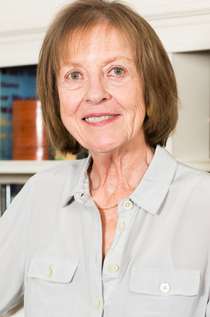Evangelicals are a potent force in American political life — they make up nearly a quarter of the population, and in the recent election, 81 percent of white, born-again evangelicals voted for Donald Trump. According to recent surveys, that support is not waning.
In These Times’ Theo Anderson delves deeply into the recent history of the religious right in his review of Frances FitzGerald’s new book.
In this excerpt from that book, The Evangelicals: The Struggle to Shape America, FitzGerald recounts the post-World War II evangelical resurgence and the rise of the religious right in politics over the past 40 years.
After the Scopes trial, in which the great lawyer Clarence Darrow defeated William Jennings Bryan in a rhetorical battle over evolution, most informed people thought fundamentalism dead. To the contrary, it grew mightily in the North, through the work of separatist pastors, radio preachers and tent revivalists, who preached to rural Americans and to those who migrated to the fast-industrializing cities in the 1920s, ’30s and ’40s.
After World War II, when Americans poured into churches and synagogues, Billy Graham, then a fundamentalist, attracted enormous crowds to his revivals. In the 1950s he became a celebrity, well known in Washington and a confidant of important men such as the oil baron Sid Richardson and Richard Nixon. His preaching evolved, and in the hope of bringing all Protestants into his big tent, he broke with the fundamentalists, and called himself an “evangelical.” The term, which had gone out of use, he and fellow moderates defined as a conservative Protestant who had been “born again.” For many years not all conservative Protestants used it, but eventually the term stuck in part because pollsters, journalists and academics used it in order to describe the confusing set of conservative denominations and independent churches. Fundamentalists then became a subset of evangelicals, and most of them were separatists who had left their denominations.
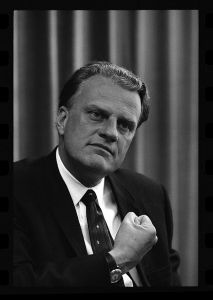
Billy Graham, 1966. (Photo by Warren K. Leffler, Library of Congress)
Graham and his mentor, Harold Ockenga, the Presbyterian pastor of the Park Street Church in Boston, knew the importance of creating institutions. Ockenga, who had helped found the Fuller Theological Seminary in Pasadena, California, formed the National Association of Evangelicals to gather conservative Protestants and create an alternative to the liberal National Council of Churches. Graham started a magazine, Christianity Today, as a rival to the liberal Christian Century. Both flourished, but soon developments within other sectors of conservative Protestantism changed the balance of power in the evangelical world. One was the explosive growth of Pentecostalism, and the spread of Pentecostal beliefs to the liberal Protestant denominations and the Catholic Church. The second was the integration of white southern evangelicals into the life of the nation for the first time since the Civil War. Of the two, the first was more surprising, but the second was more politically significant.
Pentecostalism had begun among the poor, black and white, in a Los Angeles mission in 1906. The movement had spread quickly across the South and Southwest, and segregated denominations formed, but in the 1920s and ’30s white Pentecostals, like their black counterparts, remained largely poor farmers, or people working in marginal jobs in the cities. Their distinctive belief was that all the gifts of the Holy Spirit, like speaking in tongues, prophesying and healing, were available to believers today as they were to the apostles at Pentecost. Before World War II most Protestants looked down on Pentecostals, calling them “snake-handlers” or “Holy Rollers.” In the 1950s, however, many Pentecostals became middle-class, and one of the tent revivalists, Oral Roberts, left his tent to preach on radio and television, to build a university, and to make Pentecostals respectable. In the 1960s, a time of spiritual experimentation, some of the Pentecostal beliefs caught on with liberal Protestants and Catholics, who integrated them into their own church doctrines and practices. The so‑called charismatic renewal movement took on a life of its own, spreading even to conservative Protestants.
In the same period white southerners, including evangelicals, emerged from the isolation they had proudly suffered since the Civil War. By then the dominant religious force in the South was the Southern Baptist Convention. Its theology had been untouched by modernism, and Southern Baptists thought it to be the pure Gospel of the New Testament. Until the Second World War the SBC had stood as a bastion against social change, championing states’ rights, white supremacy and the existing economic order. In the villages the church reigned supreme as the arbiter of morals, the social order and the truth of the Gospel. The arrival of northern industry, highways and federal regulations therefore came a as shock to the system. The growth of cities, improvements in education and involvement with the rest of the country created a cosmopolitan elite. Some of the heads of the SBC belonged to it and became more theologically and politically moderate. In 1954 the SBC’s Christian Life Commission persuaded the Convention to accept the Supreme Court decision on Brown v. Board of Education, and three years later its chairman acted as mediator between President Dwight Eisenhower and Gov. Orval Faubus in the conflict over admitting black students to Little Rock Central High School. What did not change was the commitment of SBC leaders to evangelism. When southerners moved out of the South, many to Southern California and the cities of the Midwest, where industry was booming, they formed their own congregations, and the SBC followed, building churches at an astonishing rate and moving out across the country until there were Southern Baptist churches in every state. The SBC’s office in Washington thus became a power to reckon with.
The 1960s and early 1970s — the so‑called Long Sixties — saw the election of the first Catholic president, the Supreme Court decision banning prayer and Bible reading in the schools, the civil rights movement, the protests against the Vietnam War and the Roe v. Wade decision. Surprisingly, only the fundamentalists objected to all of them. Other evangelicals took moderate stances on many of them, and the period passed quietly. It even saw the growth of a small evangelical left in the colleges.
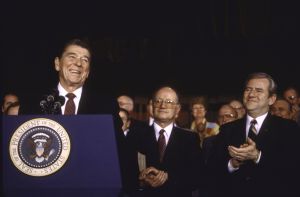
President Ronald Reagan during a speech to National Religious Broadcasters, with Rev. Jerry Falwell applauding. (Photo by Dirck Halstead/The LIFE Images Collection/Getty Images)
The reaction came later, first with the upsurge of fundamentalism in the South, and then with the appearance of new leaders. Billy Graham, who had associated himself with Nixon even during Watergate, lost his influence; separatist Baptists grew in number and fundamentalist Southern Baptists successfully challenged the moderate leaders for control of the Convention. Jerry Falwell and a host of pastors and televangelists took to national politics, forming the Moral Majority, the Christian Voice and the Religious Roundtable. A talented preacher, Falwell picked up on the grassroots rebellions against “the ’60s” in all its forms, from sex education to homosexuality, to the federal government’s insistence on the integration of Christian schools. He also voiced the southern sense that Washington was encroaching on states’ rights, and that Jimmy Carter was weak on national defense and was destroying the economy with deficit spending. Out of all this, he constructed a jeremiad that conservative Christians had to get into politics or see the destruction of the nation. With a few changes the Christian right has used the same jeremiad ever since. Falwell and Reagan created a bond that was more rhetorical than real, but the South moved gradually into the Republican Party from the presidential level on down.
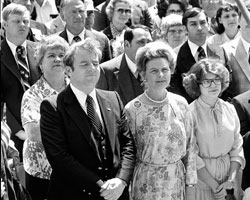
Rev. Jerry Falwell and Phillis Schlafly sing patriotic songs during a “Stop the ERA” rally in 1980. (AP Photo)
The Christian right was a populist movement, and it had only two systematic thinkers, R.J. Rushdoony and Francis Schaeffer. Of the two Rushdoony was by far the more radical. He proposed that Christians should reconstruct the society based on biblical law, a theonomy that would lead directly to the coming of Christ. Reconstructionism, his school of thought, was too outlandish to be adopted fully by more than a few people, but his ideas circulated anonymously in a watered-down form. Schaeffer, by contrast, was a major intellectual celebrity, who lectured in evangelical colleges, wrote best-selling books and made two influential documentary series, one released in 1979, condemning abortion in such vivid terms it changed the minds of thousands of evangelicals. In the book he published two years later he wrote that humanism was “a total world view” standing in complete antithesis to the “Christian world view,” and that humanists used the concept of “pluralism” to mean there was no right and no wrong. Schaeffer died in 1984, but ever since many Christian right leaders have testified to the profound influence he had on their thinking.
Jerry Falwell had to shut down the Moral Majority in the late 1980s, but he was soon succeeded by Pat Robertson, the son of a US senator from Virginia who had built a successful television network. A contradictory figure, he had political ambitions, yet to the embarrassment of his father, he hosted a television program in which he claimed to heal the sick and to avert hurricanes. In 1988 he ran for the Republican nomination for president, and when he lost, he supported the establishment candidate, Vice President George H.W. Bush.
Shortly afterward he formed the Christian Coalition to change Republican politics, with the boyish-looking Ralph Reed as his executive director. A brilliant political organizer, Reed trained Christian right activists to run in local races, figured out new tactics to attract “pro-family” voters to the Republican Party and distributed millions of voter guides favorable to socially conservative Republicans. By the 1992 election the Coalition had not only become indispensable to the Republican politicians, but also was integrated into Republican ranks and in control of the GOP apparatus in 18 states.
During the first two years of Clinton’s administration the Coalition, along with other Christian right organizations, experienced an explosive growth in membership and financing. In the midterm elections the GOP gained a major victory that put Republicans in control of the House for the first time in 40 years. White evangelicals moved decisively into the Republican camp, giving the party 75 percent of its vote. The Coalition by its account mobilized 4 million voters and helped the Republicans sweep the South. It seemed unstoppable until the House leadership decided to impeach Clinton. The effort ended in disaster for the GOP, and the Coalition broke apart, beset by financial difficulties.
By 2000 even many Christian right stalwarts almost gave up on the movement. George W. Bush, however, had been born again; he spoke their language, and he knew how much Republicans depended on the Christian right with its influence on evangelical voters. His first administration saw a growing alliance between the two because he gave them access to the White House and supported some of their favorite programs, but most of all because of what they perceived as his strong leadership after 9/11 and in waging the Iraq War. The major Christian right figures in this period were James Dobson, the founder of Focus on the Family, and Richard Land, the head of the policy arm of the conservative SBC. Like Falwell and Robertson, they believed that America had been a Christian country and would be one day again. Between them they revived the moribund movement by making a concerted effort to ban gay marriage in the states. The 2004 election was close, particularly in the key state of Ohio, and when they succeeded in passing referenda against same-sex marriage,they could take credit for Bush’s victory.
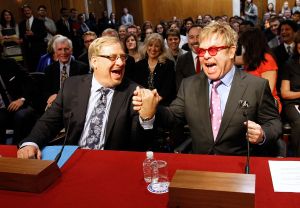
Sir Elton John, founder of the Elton John Aids Foundation, and Pastor Rick Warren shake hands before testifying at a US Senate Appropriations State, Foreign Operations and Related Programs Subcommittee hearing on Global Health Programs to urge critical support in global fight against HIV/AIDS on May 6, 2015 in Washington, DC. (Photo by Paul Morigi/Getty Images for EJAF)
In the second Bush administration the Christian right had its greatest triumphs and became more radical than before. Its alliance with the increasingly unpopular Bush administration, however, created a backlash in Congress, in the general public and even among evangelicals, who feared they had become identified merely as a part of the Republican Party. Around 2005 many leading evangelicals, such as Rick Warren, began to distance themselves from the Christian right, and some began to voice dissent publicly for the first time. Known as the “new evangelicals,” many of them took up social justice issues such as poverty and climate change.
The decline of the Christian right had begun. Falwell and other Christian right leaders, now in their 70s, died or retired, and no one took their place. The baby boomers and the subsequent generations had absorbed the social changes that had taken place since the 1960s, and many of the older concerns had receded. According to polls, the young were more inclined to worry about the environment than their elders and were more in favor of an active government at home. Abortion was an important issue for them, but homosexuality was not, and in 2007 one in three favored same-sex marriage. Most took the equality of women for granted, and on the whole they were more tolerant of the views of others and believed the US a pluralistic country.
After Obama won the 2008 election, policy-oriented new evangelical leaders faced off over the president’s health care bill against the Catholic bishops and the remaining Christian right leaders, who believed its mandates on contraception and abortion would violate their religious freedom.
The bill passed, but Obama’s victory coincided with an economic crisis that began on Wall Street and spread to Main Street, causing the worst recession since the Great Depression. The reaction this time came from the right in the form of the tea party, a movement financed by libertarian corporate barons, such as Charles and David Koch. At the grass roots level tea party members supported programs, such as Social Security, they perceived as going to productive members of society, such as themselves, but opposed government “handouts” to undeserving “freeloaders,” a category that seemed to be made up of the young, undocumented immigrants and people of color. These people, the tea party members seemed to feel, were destroying the fabric of American culture. Christian right activists, who shared much the same sentiments, melded into the tea party, the larger and more powerful group.
The “new,” or progressive, evangelical leaders fought for the cap-and-trade bill to reduce greenhouse gases in the atmosphere, for the protection of the poor against budget cuts and for immigration reform with a path to citizenship for undocumented immigrants. On immigration reform they were joined by groups such as the National Association of Evangelicals and the Southern Baptist Convention because the Bible spoke of welcoming strangers, but also because they already had Latinos and Asians in their churches, and they saw that their prospects for growth lay in evangelizing these and other immigrants.
Growth had become an important issue because in the first decade of the new century the evangelical population had plateaued. Some denominations, such as the Pentecostal Assemblies of God, were growing with Latino converts, but the enormous Southern Baptist Convention was losing members every year. What was more, the number of Americans who had no affiliation to any church was growing fast. One solution, the evangelical leaders knew, was to bring more immigrants into their churches. The trouble was that many people in the pews of white evangelical churches did not want immigrants, whom they felt were destroying American culture. They also knew that most Latinos, both Catholics and evangelicals, voted Democratic and that many supported legal abortion and same-sex marriage.
By the time of the 2016 election, the evangelical world had become a complex place. The Christian right no longer dominated evangelical discourse. Further, it had taken up a more secular language — there was little talk of Christianizing America. In Washington many thought the Christian right dead, but Republican legislators in the red states passed scores of laws restricting abortion and LGBT rights. That Donald Trump, the thrice-married libertine, won the Republican nomination for president with many evangelical votes confounded most evangelical leaders. Clearly something was happening that would change American politics, and the Christian right would not be what it had been before.
Excerpted from The Evangelicals: The Struggle to Shape America by Frances FitzGerald. Copyright © 2017 by Frances FitzGerald. Reprinted by permission of Simon & Schuster, Inc. All Rights Reserved.

